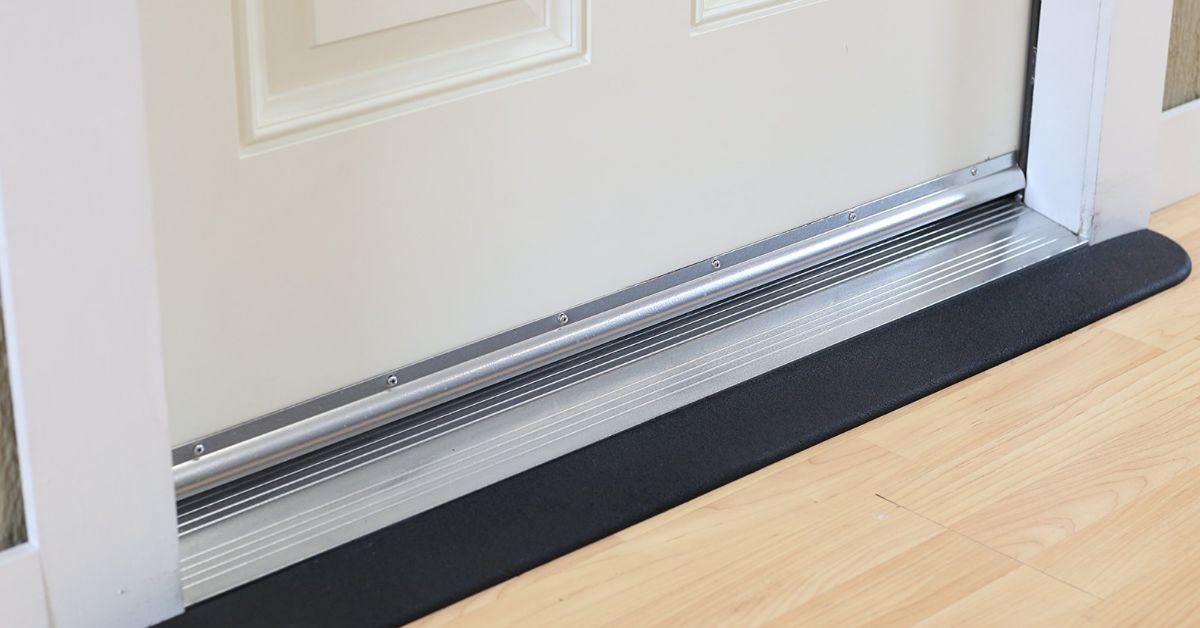The door threshold might seem like a small detail in your home’s design, but it plays a crucial role in ensuring your space is functional, secure, and visually appealing. Whether you’re building new, renovating, or simply looking to improve your existing doors, understanding the various types, materials, and installation methods of door thresholds can make a significant difference. In this comprehensive guide, we explore everything you need to know about door thresholds—from their basic purpose to the latest trends—helping you make informed choices that enhance your home’s safety and aesthetic appeal.
What Is a Door Threshold? and Why Does It Matter?
Understanding the Basics of Door Thresholds
A door threshold is a strip positioned at the bottom of a doorway, bridging the gap between two different flooring surfaces or providing a barrier against external elements. It serves as the transitional piece that seals and stabilizes the door opening, ensuring seamless movement while protecting your internal spaces from weather, pests, and drafts.
The Functional and Aesthetic Significance
Aside from its practical role, a door threshold contributes significantly to the overall look of your entrance. It can be chosen to match or complement your flooring and door styles, adding a touch of elegance or a rustic vibe, depending on your preference. Proper selection and installation of a door threshold can also improve energy efficiency, security, and comfort in your home.
Types of Door Thresholds and Their Uses
Fixed Thresholds
Description and Typical Applications
Fixed door thresholds are non-adjustable strips permanently mounted to provide a consistent seal and transition. They are common in exterior doors, especially where weatherproofing is essential.
Advantages and Limitations
They are highly durable and simple to install but lack flexibility for uneven flooring or seasonal adjustments.
Adjustable Thresholds
Features and Benefits
Adjustable thresholds come with screws or mechanisms allowing for height adjustments, making them ideal for uneven floors or seasonal expansion and contraction of materials like wood.
Suitable Scenarios
Best used in areas where flooring height varies, or for doors that frequently open and close without causing wear.
Rolling or Thresholdless Options
When and Why They Are Used
Rolling thresholds feature a smooth, often low-profile design that allows doors to glide effortlessly. Thresholdless options are minimalistic designs often used in modern interiors or sliding doors, providing an unobstructed transition.
Specialty Thresholds
Fire-Rated Thresholds
Designed to maintain fire barriers, these thresholds are tested to meet fire safety standards and are crucial in commercial and residential buildings requiring fire protection.
Soundproof Thresholds
Enhance acoustic continuity between rooms, ideal for recording studios or bedrooms.
Insulated Thresholds
Provide thermal insulation, helping to reduce energy loss and improve home efficiency.
Materials Used in Door Thresholds
Aluminum
Durability and Maintenance
Aluminum thresholds are resistant to corrosion, lightweight, and require minimal upkeep—perfect for exterior doors exposed to harsh weather.
Wood
Aesthetic Appeal and Installation Considerations
Offering a warm, natural look, wooden thresholds are best suited for interior applications but need regular treatment against moisture and pests.
Vinyl and PVC
Cost-Effectiveness and Weather Resistance
Affordable, flexible, and easy to install, vinyl thresholds are excellent for budget-conscious renovations, especially in areas prone to water exposure.
Bronze and Brass
Decorative Options and Corrosion Resistance
These materials add a touch of elegance and are highly resistant to corrosion, making them suitable for upscale entrances.
Composite Materials
Modern and Hybrid Options
Composites combine durability with aesthetic versatility, often mimicking natural wood or metal while providing enhanced longevity.
The Essential Functions of a Door Threshold
Sealing and Weatherproofing
Blocking drafts, water, and pests
A well-chosen door threshold acts as a barrier, preventing water ingress, reducing heating and cooling costs, and keeping pests out.
Transition and Alignment
Creating a smooth transition between different flooring types
It levels the change from hardwood to tile, carpet, or laminate, providing safety and a polished look.
Security Enhancement
Preventing forced entry and providing stability
Some thresholds include locking mechanisms or reinforce the door’s base, adding an extra layer of security.
Aesthetic Finish
Completing the appearance of doorways
The right door threshold complements your door style, making your entrance inviting and cohesive.
How to Properly Install a Door Threshold
Preparation
Measuring and selecting the right threshold
Careful measurement of the door width, flooring height, and existing gap is vital. Use a tape measure for accuracy and choose a threshold material compatible with your flooring.
Tools Required
Basic tools include a measuring tape, saw (for cutting), drill, screws, sealant, and a level to ensure proper alignment.
Step-by-Step Installation Process
Removing Old Thresholds
Start by carefully detaching the existing threshold, removing debris and cleaning the surface.
Fitting the New Threshold
Cut the threshold to fit the width of your door opening, ensuring a snug fit. Use a level for precision.
Securing and Sealing
Use screws to anchor the threshold firmly, and apply weatherproof sealant along the edges to prevent leaks.
Common Challenges and How to Address Them
Misalignment
Always double-check measurements and adjust before securing permanently.
Ensuring Proper Sealing
Seal all gaps with high-quality weatherstripping or caulking for optimal protection.
Choosing the Right Door Threshold: Factors to Consider
Climate and Weather Conditions
Opt for waterproof and insulated thresholds if you live in a rainy or cold climate to enhance energy efficiency.
Flooring Compatibility
Ensure the threshold material matches or complements your flooring type for a cohesive look.
Door Type and Usage
Interior doors with light traffic can use simple thresholds, while exterior or high-traffic doors require more durable options.
Aesthetic Preferences
Select finishes and styles—such as brushed brass or sleek aluminum—that align with your home’s design.
Budget Constraints
Balance quality and cost, choosing materials and types that fit your financial plan.
Maintaining Your Door Threshold: Tips for Longevity
Cleaning and Inspection
Regularly clean thresholds with mild soap and water to prevent dirt buildup. Check for damage or corrosion periodically.
Repairs and Replacements
Replace worn or damaged thresholds promptly to maintain security and insulation effectiveness.
Preventative Care
Apply protective sealants or lubricants when necessary, especially for metal thresholds, to prevent rust and corrosion.
Innovations and Future Trends in Door Thresholds
High-Tech Thresholds
Automated or Sensor-Activated Thresholds
Emerging smart thresholds can open or adjust automatically, improving convenience and accessibility.
Sustainable and Eco-Friendly Materials
Recyclable composites and natural alternatives are gaining popularity for environmentally conscious homeowners.
Customization and Personalization
From engraved patterns to bespoke finishes, thresholds now offer a high level of personalization.
Summary Table of Door Threshold Types, Materials, and Their Uses
| Threshold Type | Primary Materials | Key Features | Typical Applications |
|---|---|---|---|
| Fixed | Aluminum, Wood, Bronze | Non-adjustable, durable, weatherproof | Exterior doors, high traffic |
| Adjustable | Aluminum, PVC | Height adjustable, flexible | Uneven floors, seasonal adjustment |
| Rolling/Thresholdless | Metal, Plastic | Smooth operation, minimalist design | Modern interiors, sliding doors |
| Specialty | Fire-rated, Soundproof, Insulated materials | Specific safety or comfort features | Fire exits, soundproof rooms, energy-efficient zones |
FAQs About Door Thresholds
- How do I measure for a new door threshold?
- What materials are best for outdoor thresholds?
- Can I install a threshold myself?
- How often should I replace my threshold?
- Are there thresholds that improve home security?
- What is the most cost-effective material for thresholds?
- Are there eco-friendly options for thresholds?
- What trends are shaping the future of door thresholds?
Measure the width of the door frame and the height difference between flooring surfaces. Always add a little extra for clearance and sealing.
Aluminum, bronze, and composite materials are durable and weather-resistant, making them ideal for outdoor use.
Yes, with proper tools and measurements, many thresholds can be installed as a DIY project. However, professional installation may be preferable for complex or fire-rated thresholds.
Replace your threshold if it shows signs of damage, corrosion, or if it no longer seals properly, typically every 5-10 years depending on usage and environment.
Yes, thresholds with locks or reinforced materials add extra security at entry points.
Vinyl and PVC are generally the most economical, offering good weather resistance for a low cost.
Recyclable composites and sustainably sourced wood are increasingly popular among environmentally conscious homeowners.
Smart thresholds with automation, eco-friendly materials, and customizable designs are on the rise, making thresholds smarter and more personalized.
Choosing the right door threshold is essential for ensuring your home’s safety, energy efficiency, and aesthetic appeal. Proper understanding of various types, materials, and installation techniques empowers you to pick the best option suited to your needs. Whether upgrading for security, comfort, or style, invest in quality thresholds to enhance your living environment and enjoy the seamless transition between your home’s indoor and outdoor spaces.
For more insights on building materials and home improvement, visit EnergyStar or Houzz.





